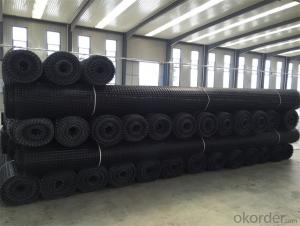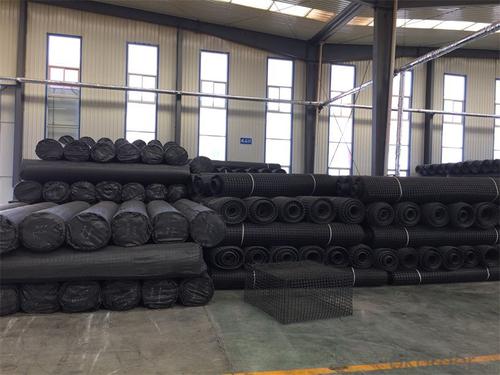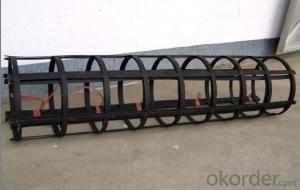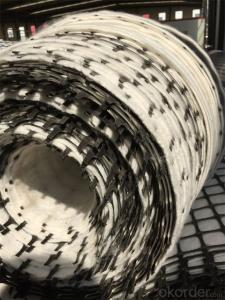Geoweb Geocells Plastic Geogrid with High Tensile Strength Warp Knitted Cmax Brand
- Loading Port:
- Tianjin
- Payment Terms:
- TT OR LC
- Min Order Qty:
- 20000 m²
- Supply Capability:
- 50000000 m²/month
OKorder Service Pledge
OKorder Financial Service
You Might Also Like
Fiberglass Geogrid Introduction:
Fiberglass geogrid is a kind of planar mesh material using alkali-free fiberglass yarn as base body and then coated with high quality modified asphalt. It is warp knitted with oriental structure which gives full play of yarn strength and improves its mechanical property to make the product high tensile, tearing and creep-resistant. Moreover, the composite property of coating with asphalt makes full protection of the fiberglass matrix and greatly improves its wear and shear resistance. All the advantageous functions make the product have a good performance in pavement strengthening, track cracking and solving difficulties of strengthening the bituminous pavement.
Fiberglass Geogrid Features:
1. Light weight, high tensile strength, high modulus, low elongation and good toughness.
2. Corrosion resistance, no long-term creep, long life span.
3. Good physical and chemical stability and good thermal stability.
4. Resistant to fatigue cracking, high-temperature track and low temperature shrinkage cracking.
5. Delaying and decreasing crack reflection.
Specifications | PET20-20 | PET30-30 | PET40-40 | PET50-50 | PET80-80 | PET100-100 | PET120-120 |
Elongation(%) | 10%~15% | ||||||
Vert Tensile strength(KN/m) | 20 | 30 | 40 | 50 | 80 | 100 | 120 |
Horiz Tensile strength(KN/m) | 20 | 30 | 40 | 50 | 80 | 100 | 120 |
Grid(mm) | 12.5×12.5 20×20 24.5×24.5 | ||||||
Width(m) | 1—6 | ||||||
Fiberglass Geogrid Application:
1. Road surface asphalt overlay construction engineering; Asphalt layers
reinforcement.
2. Converting old cement concrete road into composite road; Restraining
reflection cracking caused by block shrinkage.
3. Road extension; Preventing and controlling the cracking caused by new
and old combination and uneven settlement.
4. Treatment of the conjunction between tunnel and bridge or foundation.
Packaging & Shipping:









FAQ:
1. How to order your geogrid ?
a) Tensile strength in warp & weft direction
b) Grid size
c) Roll Width and length
d) Quantity
2. What is the Payment term?
a) TT
b) LC AT SIGHT
c) cash
d) 30% contact value as deposit ,the blance 70% be paid after received the copy of bl .
3. Delivery time
a) 19-25 days after received your depsit .
4. What is MQQ ?
a) 2500 m2 as MQQ , we can also produce sample for you .
Welcome to send your inquiry to us, and if you have any question, we can also help you.
- Q: Can geogrids be used in shoreline protection?
- Yes, geogrids can be used in shoreline protection. Geogrids are commonly used to stabilize and reinforce soil, including in coastal areas. They can provide erosion control, improve soil stability, and enhance the overall resilience of shorelines against waves and tidal forces.
- Q: Can geogrids be used in reinforcement of underground structures?
- Yes, geogrids can be used in the reinforcement of underground structures. Geogrids are designed to provide stability and support to soil structures, including underground structures such as tunnels, retaining walls, and basements. They help to distribute loads, reduce soil settlement, and increase the overall strength and stability of the structure.
- Q: What is the recommended depth of geogrid installation?
- The recommended depth of geogrid installation can vary depending on the specific project and soil conditions. However, in general, it is recommended to install geogrids at a depth of at least 12 inches to provide adequate stabilization and reinforcement to the soil.
- Q: Are geogrids resistant to UV degradation?
- Yes, geogrids are generally resistant to UV degradation. They are designed to withstand prolonged exposure to sunlight without significant degradation or loss of strength.
- Q: Can geogrids be used in slope protection systems?
- Yes, geogrids can be used in slope protection systems. Geogrids are commonly used to reinforce slopes by providing stability and preventing soil erosion. They can be installed horizontally or vertically to improve the strength of the soil and enhance the overall performance of slope protection systems.
- Q: Can geogrids be used in reinforced earth structures?
- Yes, geogrids can be used in reinforced earth structures. Geogrids are commonly employed as reinforcement materials in applications such as retaining walls and slopes to enhance the stability and strength of the structure. They provide reinforcement by distributing loads, reducing soil movement, and increasing overall stability.
- Q: Geogrid prices, the price of geogrid, geogrid latest offer
- Biaxially stretched plastic grid, uni directional plastic geogrid.
- Q: What is the difference between nonwoven geotextiles and geotextile? What is their role?
- Geomembrane is a kind of composite material. The utility model is composed of a HDPE geomembrane and a non-woven geotextile filter fabric, which is composed of a nonwoven geotextile filter +HDPE geomembrane and a non-woven geotextile filter fabric, which is compounded with a HDPE geomembrane, and has good waterproof effect.Role: River, dam, reservoir, landscape lake seepage are impervious to the material.
- Q: Can geogrids be used in railway track bed stabilization?
- Yes, geogrids can be used in railway track bed stabilization. Geogrids are commonly used in civil engineering projects to reinforce soil and provide stability. In the case of railway track bed stabilization, geogrids can be installed to improve the stability and strength of the track bed, reducing the risk of settlement and deformation. They help distribute the load and reinforce the subgrade, preventing the track from shifting or sinking.
- Q: What are the limitations of using geogrids?
- Geogrids have certain limitations that need to be considered. First, they are not suitable for all soil types and conditions, as they may not provide sufficient reinforcement or stability in certain situations. Additionally, geogrids are not effective in controlling erosion or preventing soil movement on their own; they need to be combined with other erosion control measures. Furthermore, installation and maintenance of geogrids can be complex and require expertise, making them more expensive compared to traditional soil stabilization methods. Finally, geogrids have a limited lifespan and may degrade over time, requiring replacement or repair.
Send your message to us
Geoweb Geocells Plastic Geogrid with High Tensile Strength Warp Knitted Cmax Brand
- Loading Port:
- Tianjin
- Payment Terms:
- TT OR LC
- Min Order Qty:
- 20000 m²
- Supply Capability:
- 50000000 m²/month
OKorder Service Pledge
OKorder Financial Service
Similar products
Hot products
Hot Searches
Related keywords






























